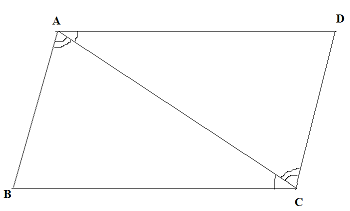
Show that a diagonal of a parallelogram divides into two congruent triangles and hence prove that the opposite sides of a parallelogram are equal.
Answer
512.1k+ views
Hint: First we make the diagram of a parallelogram with any one of the diagonal. After this, in the two triangles formed we will check for the congruency of the triangles. Here one side and two angles formed on the line are equal. So both triangles are congruent by ASA rule of congruence.
Complete step-by-step answer:
The diagram for the question is as below:

Diagonal AC divides the parallelogram into two triangles $\vartriangle $ABC and $\vartriangle $ADC.
In $\vartriangle $ABC and $\vartriangle $ADC:
$\because $ AD||BC
$\angle $BAC = $\angle $DCA ( By alternate angle)
AC = AC (Common side)
$\angle $BCA = $\angle $DAC ( By alternate angle)
In these two triangles, one side and two angles made on this side are equal.
Therefore by ASA rule of congruence:
$\vartriangle $ABC $ \cong $ $\vartriangle $ADC.
Since, both these triangles are congruent. So, all the corresponding sides and angles of one triangle are equal to that of the other.
$\therefore $ AD= BC
And AB = CD.
Therefore, it is proved that the diagonal of a parallelogram divides it into two congruent triangles and also opposite sides of a parallelogram are equal.
Note- In the question where you have to show two triangles congruent. You should remember the following rule of congruence:
1.SSS (All corresponding sides of one triangle is equal to other triangle)
2.SAS (Two sides and one angle between the two sides of one triangle is equal to the other)
3. ASA (one side and two angles made on this side are equal)
4.RHS ( This is for right triangles. One side and hypotenuse of one right triangle is equal to other right triangle)
Complete step-by-step answer:
The diagram for the question is as below:

Diagonal AC divides the parallelogram into two triangles $\vartriangle $ABC and $\vartriangle $ADC.
In $\vartriangle $ABC and $\vartriangle $ADC:
$\because $ AD||BC
$\angle $BAC = $\angle $DCA ( By alternate angle)
AC = AC (Common side)
$\angle $BCA = $\angle $DAC ( By alternate angle)
In these two triangles, one side and two angles made on this side are equal.
Therefore by ASA rule of congruence:
$\vartriangle $ABC $ \cong $ $\vartriangle $ADC.
Since, both these triangles are congruent. So, all the corresponding sides and angles of one triangle are equal to that of the other.
$\therefore $ AD= BC
And AB = CD.
Therefore, it is proved that the diagonal of a parallelogram divides it into two congruent triangles and also opposite sides of a parallelogram are equal.
Note- In the question where you have to show two triangles congruent. You should remember the following rule of congruence:
1.SSS (All corresponding sides of one triangle is equal to other triangle)
2.SAS (Two sides and one angle between the two sides of one triangle is equal to the other)
3. ASA (one side and two angles made on this side are equal)
4.RHS ( This is for right triangles. One side and hypotenuse of one right triangle is equal to other right triangle)
Recently Updated Pages
Master Class 10 General Knowledge: Engaging Questions & Answers for Success

Master Class 10 Science: Engaging Questions & Answers for Success

Master Class 10 Social Science: Engaging Questions & Answers for Success

Master Class 10 Maths: Engaging Questions & Answers for Success

Master Class 10 English: Engaging Questions & Answers for Success

Master Class 10 Computer Science: Engaging Questions & Answers for Success

Trending doubts
Why is there a time difference of about 5 hours between class 10 social science CBSE

Write a letter to the principal requesting him to grant class 10 english CBSE

What is the median of the first 10 natural numbers class 10 maths CBSE

The Equation xxx + 2 is Satisfied when x is Equal to Class 10 Maths

Which of the following does not have a fundamental class 10 physics CBSE

State and prove converse of BPT Basic Proportionality class 10 maths CBSE




